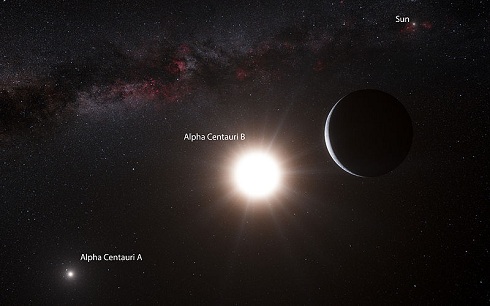The nearest solar system to ours has an Earth-sized planet…

 |
| Already there’s an artist’s impression of the newly discovered ‘Alpha Centauri B a’ |
Yes—you read right. Alpha Centauri has a planet, and it is roughly the size of Earth. And at just 4.37 light years distance, it is theoretically reachable (with a whole lot of space travel development!) despite the frustrating limitations put on us by Mr Einstein.
In a paper appearing in the journal Nature today, lead author Xavier Dumusque (Geneva Observatory, Switzerland and Centro de Astrofisica da Universidade do Porto, Portugal) explains how they use the 3.6-metre telescope at the European Space Observatory’s La Silla Observatory in Chile to detect the tiny back-and-forth wobbles to a sun’s position that are caused by the gravitational mass of a planet revolving around it.
BUT don’t pack your bags yet. This planet is closer to its sun than Mercury is to our Sun. So close in fact that it orbits it in just 3.2 days. So close that its surface temperature is likely to be around 1200 degrees Celsius.
So not exactly in the much-sought-after ‘Goldilocks zone’—that orbital distance from a sun that would allow liquid water to exist on a planet, making it theoretically hospitable to life—as we know it anyway…
And besides, while 4.37 light years sounds pretty close—that’s some 56 trillion kilometres—56,000,000,000,000 kilometres. To put that into perspective, Voyager 1 is currently 18,353,400,000 kilometres from Earth, and it was launched in 1977! How’s that in light years? Just 16 hours, 59 minutes and 38 seconds of light-travel time. So we’d probably need something like Arthur C Clarke’s Rama spaceship to make the crossing, because we’d be in there for a very long time…
Let’s just clarify some details. Alpha Centauri isn’t one star, it’s actually three:
- Alpha Centauri A (α Cen A)—about 110% the size of our Sun and 152% the luminosity
- Alpha Centauri B (α Cen B)—about 91% the size of the Sun and half its luminosity
- Proxima Centauri (α Cen C)—a red dwarf about 1/7 the size of the Sun (just 1.5 times the size of Jupiter) and less than 2% its luminosity
Alpha Centauri A and B form a binary 4.37 light years from us. The distance they are apart varies between the distance from the Sun to Saturn, and to Pluto. Proxima is gravitationally connected to the binary, but actually slightly closer—4.24 light years away, making it the closest star to our solar system. This system is so close to ours that most of the night sky viewed from any planet there would be recognisable to us, with most constellations virtually unchanged from how they look here.
 |
| Comparative star sizes |
Alpha Centauri is very easy for us to find in the Southern Hemisphere. It’s the fourth-brightest star in our skies at magnitude -0.27, is in the constellation Centauri and is also one of the Pointers to the Southern Cross—the furthest one from Crux. It’s also the brightest of the two pointers and indeed the whole Centauri constellation—hence the alpha in the name. A reasonable amateur telescope or even good binoculars will resolve the binary system, with clear differences between the sizes of the two stars. You need a fair bit better telescope and very good seeing to find Proxima…
The discovery was made using the HARPS instrument on the ESO telescope—the High Accuracy Radial Velocity Planet Searcher spectograph. Rather than detecting sideways wobbles, HARPS was able to discern variations in the star’s light due to red-shifts and blue-shifts of the forward and away aspects of the star’s wobbles! Considering that the relative velocity this movement is in the order of the speed a baby would crawl, it’s a truly remarkable achievement.
No doubt others will be looking to verify the finding over coming months. There’s a small (10 to 25%) chance that the planet could be orbiting in an elliptical plane that has it passing in front of α Cen B from our perspective. If so, the other main way that planets are found could be used. This method detects periodic dips in the star’s brightness caused by the planet’s partial eclipse, and is the way the Kepler Space Telescope has been used to find hundreds of other exoplanets.
Sources:
http://www.eso.org/public/news/eso1241/
http://www.nature.com/news/the-exoplanet-next-door-1.11605
http://bigstory.ap.org/article/earth-sized-planet-found-just-outside-solar-system
http://www.sciencenews.org/view/generic/id/345756/description/The_alien_next_door
 Follow
Follow